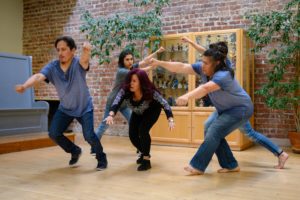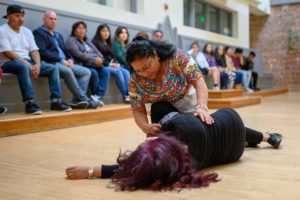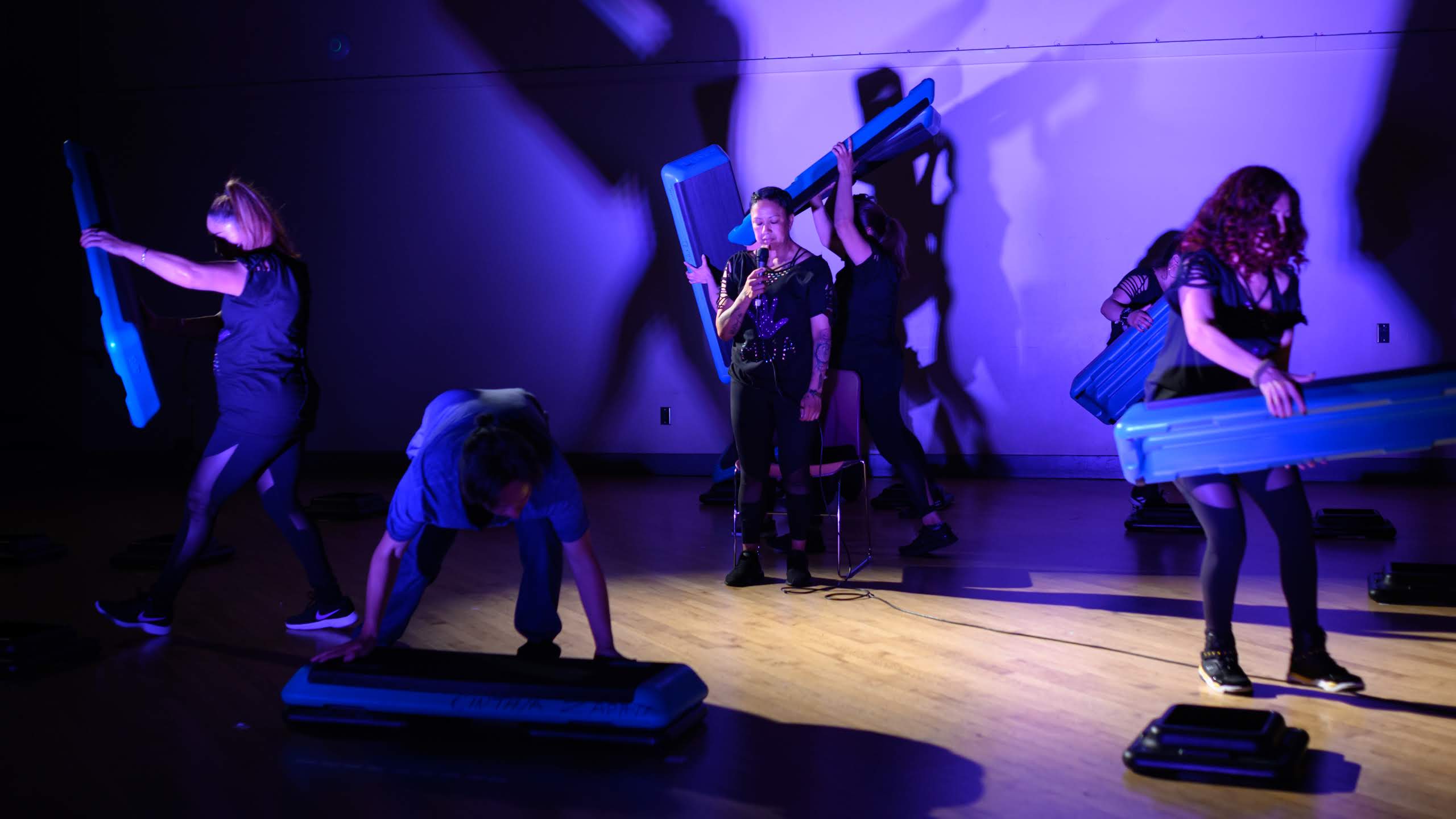Photos by Scott Tsuchitani
On our way out of Margaret Jenkins’ CHIME event on December 8, 2019, José Navarrete invited me to have a conversation about NAKA’s social justice work, including LAIR (Live Arts in Resistance), a series of performance showcases, artist residencies, and community town halls in partnership with EastSide Arts Alliance in East Oakland. By the time we found a date that worked for the three of us, COVID-19 had hit.
I’ve been watching José and his artistic partner Debby Kajiyama dance together since before they officially founded NAKA Dance Theater in 2001. Their 20-year collaboration has been rooted in formal exploration, cultural engagement, and social justice, and has spawned works that put the political and the aesthetic into critical conversation.
Debby, José, and I had our Zoom conversation on March 20 when the Bay Area had been under official lockdown for less than a week. Much of our discussion centered around their work with Mujeres Unidas Y Activas (MUA), an organization dedicated to supporting and empowering Latina immigrants. Toward the end of our talk, both Debby and José expressed concern about speaking too much for the women. José asked, “How can we talk about the work and decentralize ourselves?” So two months after our initial conversation, Debby and José sent me the transcript of interviews they conducted with two of the women of MUA who are performers in Y Basta Ya! (Enough!), a project slated to premiere in 2021. I have woven excerpts of the interviews with Adriana Embriz and Monica Gonzalez to include their perspectives on our discussion.
Sima: What do you think is the most important thing In Dance readers should know about what NAKA is doing these days? Right now is a weird time to answer that question but maybe—
Debby: It’s such a weird time to answer that question. The project we’re working on now is with Mujeres Unidas Y Activas, a Latina organization that promotes economic and personal transformation and power for Latina immigrants. Things feel so overwhelming that I don’t know what’s relevant right now. It’s relevant because I think that vulnerable populations are the hardest hit in these situations. So now we’re doing our best to try to work remotely.

Monica Gonzalez: When we began working on the project and started to write things down, I thought wow! It was a total transformation. And it made me think, I really lived through a lot — and the scene really summed it up. The message of the work is that I am still alive. Maybe God didn’t want me to go to heaven yet. He was saying, “It’s not your time yet; you better speak out, tell your story.”
Sima: What did the work look like before having to go remote and what does it look like now?
Debby: Before it meant a lot of hanging out. Oh good, José’s here. José are you here?
Sima: He’s connecting.
Debby: Hola, hola.
Sima: Hello? Let’s make sure he’s not muted. No. It still says he’s connecting to the audio. Is he—oh! Now it says he’s connected. Hello?
José: Hello?
Sima: Hey!
Debby: Hi!
José: Hi, how are you?
Sima: Good! José are you in Mexico or are you here?
José: I’m in Mexico.
Debby: Are you ok?
José: Yeah.
Debby: Ok. We’ve known Mujeres Unidas y Activas—MUA for short—for a long time. They’ve been involved in other [NAKA] activities, like The Anastasio Project. They’ve been on panels for some of our shows. Then they invited José to come and teach some movement classes for them. That’s how the relationship got started. MUA serves Latina immigrants; they do everything from one-on-one counseling to support groups. They have groups for survivors of domestic violence and sexual abuse as well as a more general support group for immigrant women who have come to this country from a variety of Latin American countries. They have English classes. They provide childcare. And they’re also really active civically. They lobby, they take trips to Sacramento. They’ve incorporated arts in their curriculum previously, but our partnership with them has really grown since José started teaching them classes. And it was kind of a big deal for them to hire a man.
Sima: I was wondering about that.
José: At first, they were looking at me strangely. One member said she was really afraid because all her relationships with men had been horrible. I told her to let me know if she wanted me to leave — that would be ok. But I’m Mexican, so we share Latin American culture in common. And I connect with them through comedy, jokes with shared cultural references. We laugh a lot. And also, I am a man teaching dance. They were like, “Oh my god; you are so weird. You are not like the men we’re used to. You’re a dancer!”
Sima: Was your sexuality explicit in this? Or was the fact that you’re a male dancer operating as code?
José: [Laughs.] I think they were like, “Hey, are you gay or something”; But the facilitators said, “We can’t give you that information.” So they were trying to be a little protective. I never said I was gay but, well, you figure it out. I never came out but they were always thinking about it.
Sima: It’s interesting to ponder the ways different parts of our identities afford us access to different communities.
José: I think our connection was cultural. We invited Juan Manuel Aldape and Marcelo Garzo Montalvo to teach and they were really accepted. The culture and the movement brought us together.
Debby: We choose the facilitators really carefully. And both Juan Manuel and Marcelo have that sensitivity toward the situation. That made it very safe. But in regards to José’s own sexuality, there is still homophobia in the community, so I don’t know if it would be a negative thing or a positive thing, safe or less safe. Negotiating that is a little bit complicated.
Sima: I was imagining that that’s what made it unspoken. Like you keep it unspoken and you let people feel comfort where they feel comfort.
Debby: Is that how you feel José?
José: Sometimes. However, there are other women who are aware of the homophobia in the community and come out and say, “This is my girlfriend. I was with an abusive man for thirty years and now this is my partner.” Even for us it was like, Wow, this is so deep. I feel like there’s this polarity, some women who are homophobic and others who really confront that in a deeply fearless way.
Debby: There were two queer/non-binary professional dancers in the process, and I noticed when the coming out would happen in the rehearsal process. [NAKA collaborator] Emelia [Martínez Brumbaugh] was talking to a MUA member who was telling a story about her son or nephew who might be gay, and Emelia said, “Oh I’m gay.” Just little things like that can help change the perception.
Adriana Embriz: I remember it was a little difficult at first because many of the women have experienced domestic violence and sexual assault. José came to lead us in healing workshops and many of the women walked out when they saw him come in. They couldn’t imagine that he, as a man, could lead women through a therapeutic healing process. Then we started to get to know him and what kind of work he did. He had to build trust with us so we wouldn’t make his life miserable [laughs]. Little by little, he started to win all of us over and we felt safe talking with him about many things. Thank goodness he is very charismatic, and gradually won over everyone. Now we all love him.
Debby: One of the founders, Maria Jimenez said they have to start thinking more about the idea that there is this group of really strong women organizing, who all go home to their families where they have sons and husbands or partners. And sometimes it’s like this different reality for them.
José: When I started to work with MUA. Maria said, “Don’t worry. It will be difficult, but we have to start to heal all members of the family.”
Adriana: It’s really hard because not all are open to having men in their healing process. Many women are still very shut down because of the violence they are living with. But as the saying goes, if you don’t do something, you can’t move forward.
Sima: How did the collaboration start?
Debby: A few years ago we started going to their domestic violence and sexual abuse survivor support group. We went regularly to the meetings. They call it a desahogo. I love this word—ahogar is the word for to drown and de is the opposite, how to undrown. For them it’s basically a time to express their feelings about really intense things and cry and have the group listen. It was a process of getting to know people and then broach the idea of moving and stretching, embodied practices. They love to dance. They love to do Zumba and Step. They love to move.
Monica Gonzalez: When you experience sexual abuse you try to forget it, or rather, to freeze the memory and pretend that nothing happened. When I started to remember more, I took a workshop on sexual assault. In the third or fourth session when we talked about sexual abuse of kids, it triggered me completely and I broke down and started to cry. From that moment, I started to remember more and more and recognized that I was a survivor of sexual abuse. It was like putting the pieces of a puzzle together from all the memories. It’s very difficult to live with all of this, but speaking the truth helps to heal—not to forget—but to heal.
Sima: Did they have a performance element in their work at that time?
Debby: They have done artistic things before. We did a show at the end of May last year that was a site-specific dance theater work in the Women’s Building in San Francisco with three NAKA dancers and women from MUA. Three women told their stories but there was a huge number of women involved. It was all in Spanish and it was really intense. All the women were really committed but the stories they told made me question whether we should tell those stories on stage.

Sima: Because of the level of trauma or because of the risk to the speaker?
Debby: I think both. We talked a lot about the risk to the performer in the rehearsals. The whole organization has been really supportive in terms of personal, one-on-one support when the performance is happening. They had their people there ready to support the women if they needed it. Like with any community collaboration where you’re dealing with stories like this, it’s always in the hands of the women and the organization as to whether the performance will happen or not. At any moment, they can say forget it, and that’s their prerogative. In the end, none of the women chose to do that. Their answers were always like, if I do that it’s like silencing myself once again. We all really feel held by the organization. They strongly believe in art as a form of healing.
Adriana: [discussing her experience creating and performing her section of Y Basta Ya] When we started, it felt like opening Pandora’s Box. When we were working on the piece, I realized that I still had many things locked away in that box that I didn’t want to open. Through the process, I realized that it wasn’t my mother’s fault, nor my grandmother’s fault. And it wasn’t my fault that this person beat me, abused me. And it’s not even his fault because he didn’t have love, didn’t have a father who paid any attention to him, or a mother to guide him. And he experienced the same kind of violence with his parents. When you start to understand this, you begin to forgive and let go of things that weigh you down. It’s very liberating. That’s what this performance did for me. In the performance, I shouted my poem at the top of my lungs. You have no idea how well I slept that night! [laughs] My shouting wasn’t just for myself; I was shouting for all those women who weren’t able to shout.
Sima: So what is NAKA’s directorial role in this work?
José: When a member is describing her story, we take notes and say things like, “This is what you said. Is that ok?” We witness what they have to say and then try to organize it into a text. Then we give it to them for them to decide if this is the story they want to tell. In terms of movement, Monica does Zumba regularly, maybe four times a week. So in her piece she wanted to do Zumba or Banco [Step Aerobics]. So we went with her friends and took classes. We gathered a group of eight women who do Zumba.
Debby: If you know the Laundromat on 25th and Mission, you go in the Laundromat and upstairs to this tiny room and there are Zumba classes and spin classes all the time.
José: So we went through the process of meeting their friends, talking with the Zumba teacher, and trying to figure out how we’re going to put this together in their story. We spend tons of time to figure out the story together. When we work with professional artists, we set a rehearsal schedule. But the time outside of rehearsal — this hanging out has allowed us to have trust and continue working on this physical storytelling.
Monica: NAKA helped me uncover my story. I started talking about small things with you both and that made me remember things. The pain was like a thread that began to unravel the past. The truth is that I wasn’t interested in remembering all that. But then you started to say to me, “You’ve experienced so many things. What would you think if we put this story into the performance?”
José: One of the most important things I’ve learned from MUA is this phrase, “Voy a hacer una plática valiente,” “I’m going to have a courageous conversation.” These talks are so difficult! You [Monica] often said that you were going to have an unbelievably difficult conversation that will make many people uncomfortable. Many people aren’t prepared to have those kinds of discussions. I have to thank you for that. I learned a lot from you about these incredibly brave conversations and how they are a path toward healing.
Sima: Other than having to move to an online process, what else has changed?
José: The needs of the group are changing, and we are trying to support that. They are extremely vulnerable at this time, not only because of the virus, not only because of losing their jobs, but also the fear of deportation that is still happening. It’s real.
Debby: The women who are dealing with domestic violence are being forced to be at home. It’s not a safe place at all.
José: So right now we are creating virtual group support. Most of them are connected on Facebook and WhatsApp. But we wanted to create some regular meetings of small groups where they can talk and create activities. We started two days ago. We’re in the process of figuring out what would be the best place for us to have a virtual group support. Everything is about technology and what kind of access the women may have. So far they are being connected.

Debby: I keep getting distracted by my phone because it keeps buzzing because they’re having a conversation right now. I think there’s probably thirty or so women in the group and spontaneously someone will start a video call and people will join. Not being in person is really hard. We’re still building trust. Luciana Rodriguez, one of the group’s facilitators, asked folks to send her a photo with a positive statement that will help support all of the community so she could pull those together and make a collage. One woman said to destress she does Zumba in her living room by herself. I said, maybe you should do that while we’re on this video chat and everyone can follow you so we can all do it together. That’s the level that it’s at after two days.
Adriana: I’m taking a lot of classes online with MUA and other classes too. It helps me deal with the situation and I try to apply what I’m learning to support other women. If someone needs support, I make myself available to talk with them. I’m also practicing self-care—exercising and trying not to gain too much weight because it makes it more difficult for me to walk in my physical condition. I’ve put a lot of attention in trying to avoid feeling anxious or desperate. I keep myself busy. I want to share my healing process. It’s a long process, but I have seen my own transformation, and I would like to let women know that they can heal themselves.
This article appeared in the Spring/Summer 2020 issue of In Dance.



